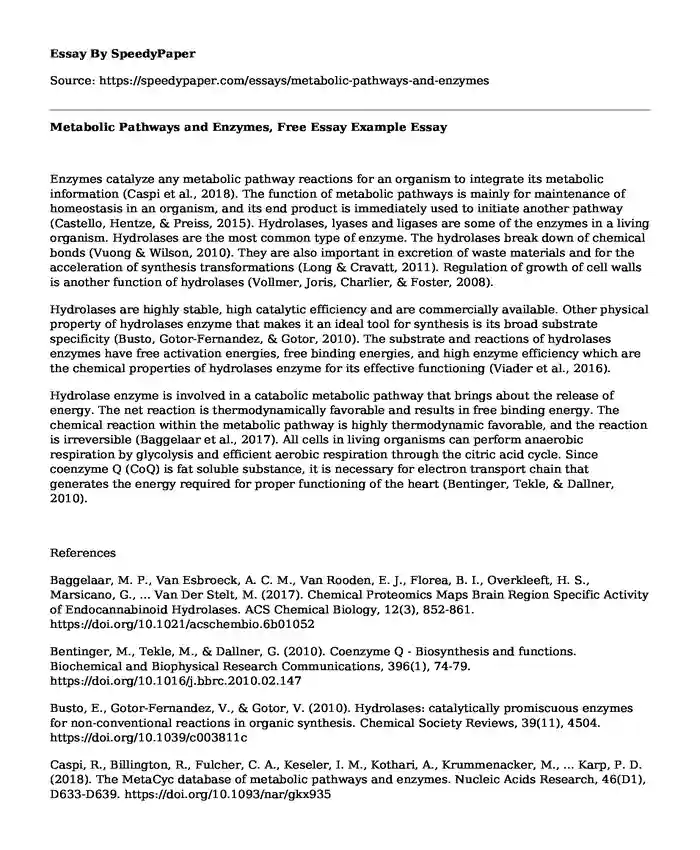Enzymes catalyze any metabolic pathway reactions for an organism to integrate its metabolic information (Caspi et al., 2018). The function of metabolic pathways is mainly for maintenance of homeostasis in an organism, and its end product is immediately used to initiate another pathway (Castello, Hentze, & Preiss, 2015). Hydrolases, lyases and ligases are some of the enzymes in a living organism. Hydrolases are the most common type of enzyme. The hydrolases break down of chemical bonds (Vuong & Wilson, 2010). They are also important in excretion of waste materials and for the acceleration of synthesis transformations (Long & Cravatt, 2011). Regulation of growth of cell walls is another function of hydrolases (Vollmer, Joris, Charlier, & Foster, 2008).
Hydrolases are highly stable, high catalytic efficiency and are commercially available. Other physical property of hydrolases enzyme that makes it an ideal tool for synthesis is its broad substrate specificity (Busto, Gotor-Fernandez, & Gotor, 2010). The substrate and reactions of hydrolases enzymes have free activation energies, free binding energies, and high enzyme efficiency which are the chemical properties of hydrolases enzyme for its effective functioning (Viader et al., 2016).
Hydrolase enzyme is involved in a catabolic metabolic pathway that brings about the release of energy. The net reaction is thermodynamically favorable and results in free binding energy. The chemical reaction within the metabolic pathway is highly thermodynamic favorable, and the reaction is irreversible (Baggelaar et al., 2017). All cells in living organisms can perform anaerobic respiration by glycolysis and efficient aerobic respiration through the citric acid cycle. Since coenzyme Q (CoQ) is fat soluble substance, it is necessary for electron transport chain that generates the energy required for proper functioning of the heart (Bentinger, Tekle, & Dallner, 2010).
References
Baggelaar, M. P., Van Esbroeck, A. C. M., Van Rooden, E. J., Florea, B. I., Overkleeft, H. S., Marsicano, G., ... Van Der Stelt, M. (2017). Chemical Proteomics Maps Brain Region Specific Activity of Endocannabinoid Hydrolases. ACS Chemical Biology, 12(3), 852-861. https://doi.org/10.1021/acschembio.6b01052
Bentinger, M., Tekle, M., & Dallner, G. (2010). Coenzyme Q - Biosynthesis and functions. Biochemical and Biophysical Research Communications, 396(1), 74-79. https://doi.org/10.1016/j.bbrc.2010.02.147
Busto, E., Gotor-Fernandez, V., & Gotor, V. (2010). Hydrolases: catalytically promiscuous enzymes for non-conventional reactions in organic synthesis. Chemical Society Reviews, 39(11), 4504. https://doi.org/10.1039/c003811c
Caspi, R., Billington, R., Fulcher, C. A., Keseler, I. M., Kothari, A., Krummenacker, M., ... Karp, P. D. (2018). The MetaCyc database of metabolic pathways and enzymes. Nucleic Acids Research, 46(D1), D633-D639. https://doi.org/10.1093/nar/gkx935
Castello, A., Hentze, M. W., & Preiss, T. (2015). Metabolic Enzymes Enjoying New Partnerships as RNA-Binding Proteins. Trends in Endocrinology and Metabolism. https://doi.org/10.1016/j.tem.2015.09.012
Long, J. Z., & Cravatt, B. F. (2011). The metabolic serine hydrolases and their functions in mammalian physiology and disease. Chemical Reviews. https://doi.org/10.1021/cr200075y
Viader, A., Ogasawara, D., Joslyn, C. M., Sanchez-Alavez, M., Mori, S., Nguyen, W., ... Cravatt, B. F. (2016). A chemical proteomic atlas of brain serine hydrolases identifies cell type-specific pathways regulating neuroinflammation. eLife, 5(JANUARY2016). https://doi.org/10.7554/eLife.12345
Vollmer, W., Joris, B., Charlier, P., & Foster, S. (2008). Bacterial peptidoglycan (murein) hydrolases. FEMS Microbiology Reviews. https://doi.org/10.1111/j.1574-6976.2007.00099.x
Vuong, T. V., & Wilson, D. B. (2010). Glycoside hydrolases: Catalytic base/nucleophile diversity. Biotechnology and Bioengineering. https://doi.org/10.1002/bit.22838
Cite this page
Metabolic Pathways and Enzymes, Free Essay Example. (2022, Apr 11). Retrieved from https://speedypaper.net/essays/metabolic-pathways-and-enzymes
Request Removal
If you are the original author of this essay and no longer wish to have it published on the SpeedyPaper website, please click below to request its removal:
- Free Essay on Factors Influencing Adoption of Green Technology on a Manufacturing Firm
- Law Essay Sample on Grand Larceny
- Creating Snort Rules, Free Essay on Computer Science
- Law Essay Example: Legislation for Built-to-Rent Sector in Australia
- Essay Example: The Role of Music in Movies by Bridgette Redman
- Film Review: My Sister's Keeper - Free Essay
- Paper Example: Formal Analysis of Court of San Martino, Venice
Popular categories





